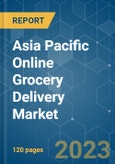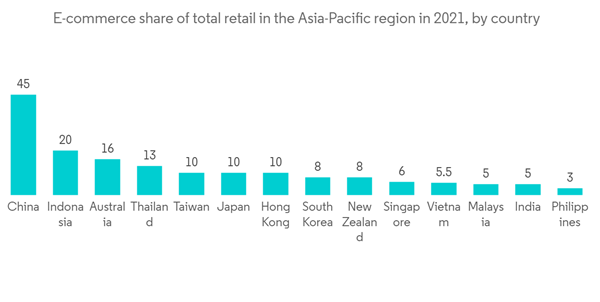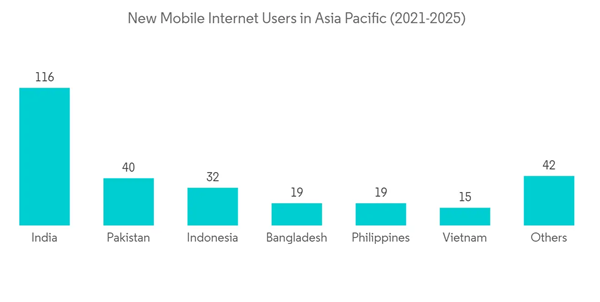Key Highlights
- The market is expected to observe substantial growth during the forecast period. The COVID-19 pandemic created a massive surge in demand for online grocery delivery services. Also, Government-encouraged no-contact deliveries and online payment options have attracted people toward online grocery delivery services.
- Global and local online shopping platforms such as Amazon, Blinkit, and Flipkart quickly changed their delivery services, boosting the demand for online grocery delivery services in the region. People working from home, increasing disposable income, and ease of use of these platforms are some driving factors of the market growth.
- During and after the COVID-19 pandemic, the new normal of personal hygiene and social distancing for safety drove people in the region toward online grocery delivery services, as Asia Pacific was one of the largely affected regions. The market is also anticipated to benefit from declining internet prices and cheaper smartphones in the Asia Pacific. The growing adoption of digital payment and ever-increasing internet penetration in the region also fuel the market's growth.
- AI-based tools are being used to drive personalization of the grocery shopping experience. Artificial intelligence in online grocery shopping is used to collect data regarding customers from various sources. The data is mainly collected from offline outlets, online channels, and users' actions on the site. After that, the data is applied to understand the target clients' needs more efficiently. AI also helps grocery stores keep track of holidays, weather, seasonality, and festivals to serve their customers better.
Asia-Pacific Online Grocery Delivery Market Trends
Retail delivery segment is anticipated to grow at a significant CAGR.
- The retail delivery segment dominated the market in 2020. The noteworthy share of the segment is attributed to the constant shopping of kitchen staples such as flour, refined oil, and grains during the lockdowns. During the lockdown, people were afraid that the food supply would be short as the supply chain was affected mainly, so people started stocking up the goods at home by ordering them online.
- Moreover, Increasing online delivery of dairy products and baked goods such as bread and muffins is expected to aid the segment in maintaining its dominance during the forecast period. Various online delivery services offer subscription-based delivery of dairy and baked goods as these are daily kitchen staples and do not have a longer shelf life. The subscription comes with daily, twice-a-week, and once-a-week deliveries, making it easy for the customers to choose as per their needs.
- After Retail delivery, the quick commerce segment is projected to grow significantly during the forecast period. A rising number of people are willing to pay more for fast deliveries and changing lifestyles and shopping habits. The people, such as top-up purchases and frequent unplanned grocery shopping sprees, have fuelled the demand for quick commerce services in the region.
- Although metro and tier-I cities are major contributors to the segment's growth, these cities already have saturated quick commerce services. All the market players are now focusing on tier-II cities in the Asia Pacific region. These cities have shown great potential for the growth of the segment in the past few years.
China is projected to hold the largest share of the market.
- The country's growth is credited to the presence of multiple leading market players and the most significant number of online shopping consumers in the country. Amazon is the most preferred online grocery in the overall Asia Pacific region. However, various local delivery services are also fighting for dominance in the major cities in APAC. The shifting customer demographic and buyers becoming more comfortable with online shopping have been the major factors in developing the online grocery delivery market in the region.
- Additionally, in India, the government is encouraging the digital economy framework as well as digital literacy; owing to these things, the online grocery delivery market in India is anticipated to observe an additional spur in its growth.
- The market's growth is attributed to the customers in tier- I cities such as Delhi, Bangalore, Mumbai, and Chennai. These cities have high adoption of online grocery shopping as they have more resources than smaller cities, such as logistics, high-speed internet, and better access to smart devices. After the Covid-19 pandemic, the city population was more concerned about safety and hygiene as these cities faced most of the negative impact as they are densely populated.
- Such factors are turning out to be driving factors for the growth of the online grocery delivery market in the country. Moreover, the government making efforts to restore the supply chain and digitalization of the cities is also one of the key factors aiding the growth of the market.
Asia-Pacific Online Grocery Delivery Industry Overview
The online grocery delivery market is fragmented. Moreover, there is great competition between the local and global market players. Key players are concentrating on increasing their presence in the market by applying various strategies that include mergers & acquisitions, partnerships, and expansion in various countries. These strategies are anticipated to benefit the market players in developing their offerings and regional presence. Also, they are expected to improve their services across the market in the region. A few major players in the market include Amazon.com Inc., Coles Group Ltd., Costco Wholesale Corp., SPAR International, and Walmart Inc. Due to its rapid growth, various new players are trying to enter the market in the region.In November 2022, U.K.-based company Ocado announced its plans to automate its e-commerce warehouses in south Korea and South Asia with know-how push technology. The company plans to partner with the leading online grocers in the region, such as Coles in Australia, to promote its automated warehouses. The acceptance of advanced technology by the key players in the online grocery delivery market is aiding the overall growth of the market in the region.
In February 2022, Rakuten Group, Inc announced the launch of its online grocery delivery service in Japan, “Rakuten Zenkoku Super.” Rakuten Zenkoku Super symbolizes the next move in the development of grocery shopping in Japan. The newly designed service is created to drive supermarkets nationwide to reach new areas and age groups of people by offering them a wide-ranging online grocery shopping platform. The platform is designed to deliver goods promptly to clients.
Additional Benefits:
- The market estimate (ME) sheet in Excel format
- 3 months of analyst support
This product will be delivered within 2 business days.
Table of Contents
1 Asia Pacific Online Grocery Delivery Market2 INTRODUCTION
2.1 Study Assumptions and Market Definition
2.2 Scope of the Study
3 RESEARCH METHODOLOGY
4 EXECUTIVE SUMMARY
5 MARKET INSIGHTS
5.1 Market Overview
5.2 Industry Attractiveness - Porter's Five Forces Analysis
5.2.1 Bargaining Power of Suppliers
5.2.2 Bargaining Power of Consumers
5.2.3 Threat of New Entrants
5.2.4 Threat of Substitute Products
5.2.5 Intensity of Competitive Rivalry
5.3 Impact of COVID-19 on the Market
6 MARKET DYNAMICS
6.1 Market Drivers
6.1.1 Shift in Shopping Mode Preferences of the people
6.1.2 Increasing Urbanization
6.1.3 Growing Disposable Income
6.2 Market Restraints
6.2.1 High-priced products and additional delivery charges
6.2.2 Inconsistency in product quality
7 MARKET SEGMENTATION
7.1 By Product Type
7.1.1 Retail Delivery
7.1.2 Quick Commerce
7.1.3 Meal Kit Delivery
7.2 By Geography
7.2.1 India
7.2.2 China
7.2.3 Japan
7.2.4 South Korea
7.2.5 Thailand
7.2.6 Indonesia
7.2.7 Australia
7.2.8 Rest of Asia-Pacific
8 COMPETITIVE LANDSCAPE
9 INVESTMENT ANALYSIS
10 FUTURE OUTLOOK OF THE MARKET
10.1 Amazon.com Inc.
10.1.1 Blink Commerce Pvt. Ltd.
10.1.2 Carrefour SA
10.1.3 Coles Group Ltd.
10.1.4 Costco Wholesale Corp.
10.1.5 Flipkart Internet Pvt. Ltd.
10.1.6 Swiggy (Instamart)
10.1.7 METRO Cash and Carry India Pvt. Ltd.
10.1.8 SPAR International
10.1.9 Walmart Inc.
Methodology

LOADING...










